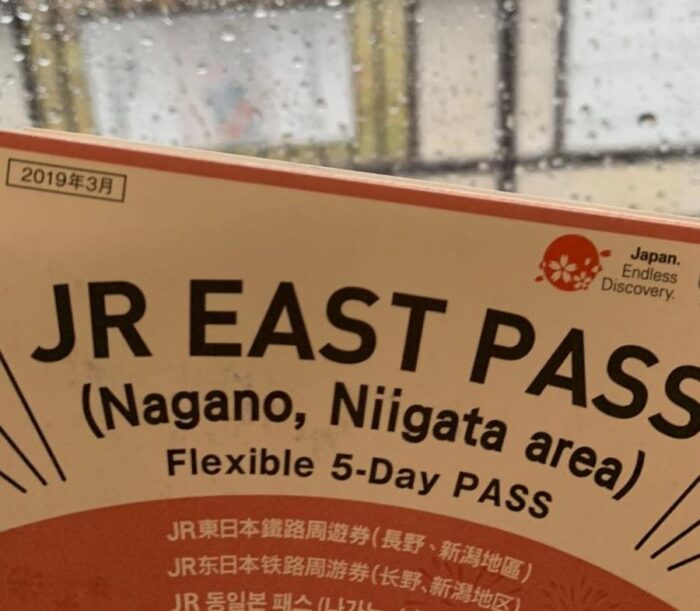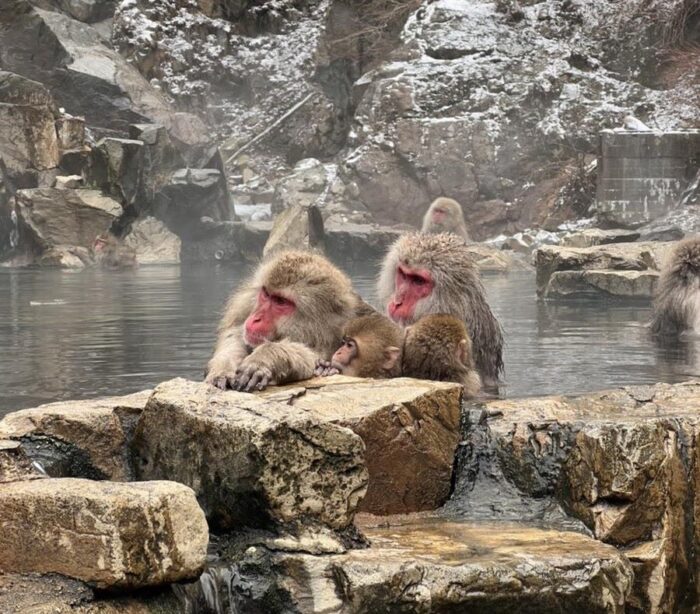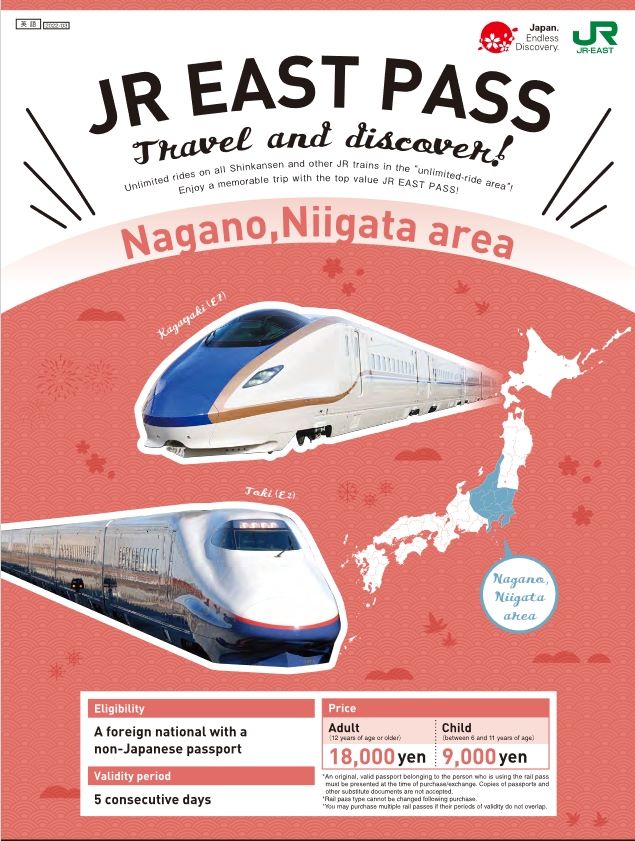If you’re planning a trip to Japan and want to explore the beautiful Nagano and Niigata regions, the JR EAST PASS (Nagano, Niigata area) is an excellent choice.
This rail pass provides unlimited travel on designated trains operated by the East Japan Railway Company (JR East), including the shinkansen bullet trains, for 5 days.
In this article, we’ll explore the benefits of the JR EAST PASS (Nagano, Niigata area) and offer some tips for making the most of your travels in Japan.
Key Take Aways:
- The pass offers unlimited travel on designated trains operated by the East Japan Railway Company (JR East) in the Nagano and Niigata regions, including the shinkansen bullet trains, local trains, and limited express trains.
- The pass is valid for 5 consecutive days of travel
- The cost is 18000 for adults and 9,000 for kids
- You can purchase online with Klook, via the JR east website, or at a JR ticket office in Japan
- In addition to Nagano and Niigata prefectures, the pass also covers parts of Tochigi, Ibaraki, Chiba, Gunma, Saitama, Tokyo, Kanagawa, Yamanashi, and Shizuoka prefectures.
- With the pass, you can easily visit popular destinations such as Snow Monkey Park, Zenko-ji Temple, Matsumoto Castle, and Lake Kawaguchi.

How Much Is The Pass?
Here are the prices for the pass:
Adults (12 years and older): 18,000 yen for 5 days
Children (6-11 years): 9,000 yen for 5 days
The price is the same whether you purchase with JR east
Who Can Purchase The Pass?
The JR EAST PASS (Nagano, Niigata area) can be purchased by anyone who meets the eligibility requirements, which include foreign tourists visiting Japan on a short-term stay (under 90 days) with a non-Japanese passport. Additionally, residents of Japan who hold a non-Japanese passport and meet certain other conditions may also be eligible to purchase the pass.
How To Purchase The Pass
For those looking to purchase the JR EAST PASS (Nagano, Niigata area), there are three ways to do so:
1 Purchasing a Pass Oline
- Purchase a voucher (e-ticket) from a travel agency or online service before your arrival in Japan
- Present the voucher and your passport at a pick-up location in Japan
2 Purchasing a Pass Online on the JR-EAST Train Reservation Website
- Purchase the pass on the JR-EAST Train Reservation website
- An eligibility check will be conducted upon pass pick-up in Japan
3 Purchasing at a Ticket Office in Japan
- Present your passport at a JR Pass Ticket office
- An eligibility check will be conducted before the purchase
Some additional information to keep in mind when purchasing and using the pass:
- You must be a foreign national with a passport issued by a country other than Japan to be eligible to use the pass
- Passes can only be purchased and collected by the pass user themselves, who must present their passport at the time of purchase and pick-up
- Passes cannot be collected using a copy of the passport, an original passport with an IC chip is required for purchases at a Reserved Seat Ticket Vending Machine with a passport reader
- Passes must be collected within three months of purchase
- Passes are valid for 5 days from the indicated start date
Benefits of the JR EAST PASS (Nagano, Niigata area)

One of the biggest benefits of the JR EAST PASS (Nagano, Niigata area) is that it’s incredibly convenient. The pass allows you to travel to and from Nagano and Niigata with ease and gives you unlimited access to the JR East rail network in these regions. This means you can explore the area at your leisure, visiting multiple attractions and taking in the stunning scenery.
Another advantage of the JR EAST PASS (Nagano, Niigata area) is that it’s affordable. For one flat fee, you can enjoy unlimited travel on the designated trains for 5 consecutive days. This is particularly useful if you’re on a budget and want to see as much of the region as possible without spending a fortune.
With the JR EAST PASS (Nagano, Niigata area), you can easily visit popular destinations such as Nagano, Yuzawa, Niigata, and Snow Monkey Park. You can also explore some of the area’s lesser-known gems, including picturesque mountain villages and quaint hot spring towns. With the pass, the possibilities for adventure are endless.
What Area Does The JR East Pass (Nagano And Niigata)

Despite the Name, the JR EAST PASS (Nagano, Niigata area) covers more than just the Nagano and Niigata prefectures. In addition to these two prefectures, the pass also allows for travel to the following prefectures:
- Tochigi
- Ibaraki
- Chiba
- Gunma
- Saitama
- Tokyo
- Kanagawa
- Yamanashi
- Shizuoka
That’s 11 prefectures all up which means that travelers with the pass can explore a wider range of destinations in the Kanto region and beyond, making it a versatile and valuable pass.
Which Train Services Are covered?
Here’s a summary of the information about transportation options included with the JR EAST PASS (Nagano, Niigata area):
The JR EAST PASS (Nagano, Niigata area) provides unlimited travel on lines in the area covered, allowing you to visit a wide range of destinations.
The pass can be used on various railway companies and lines, including:
- JR EAST Lines
- Tokyo Monorail
- Izu Kyuko Line
- Hokuetsu Express
- Echigo TOKImeki Railway (between Naoetsu and Arai)
- Reserved seats in ordinary cars of specific express trains with through operations between JR East and Tobu Railway lines: Nikko, Kinugawa, and SPACIA Kinugawa trains.
- Ordinary trains (including rapid trains) on the Tobu Railway lines between Shimo-imaichi and Tōbu-nikkō / Kinugawa-onsen.
- JR buses in the area (exc. highway and some regular bus routes)
When using the pass on Tobu Railway lines, there are some restrictions to keep in mind. Express trains that both depart from and terminate at stations on Tobu Railway lines are not covered by the pass. The pass can only be used on Tobu Railway lines if the train either departs from or terminates at a JR station.
Special Trains You Can Ride With The JR East Nagano & Niigata Pass
Known as “Joyful Trains” here are some of the cool special trains that you can ride on with the pass. note that reservations may be required.

- Oykot: A special limited express train that runs between Nagano and Minami-Otari, offering panoramic views of the Northern Japan Alps.
- KAIRI: A local train that runs between Echigo-Yuzawa and Muikamachi, offering scenic views of the countryside in Niigata Prefecture.
- HIGH RAIL 1375: a limited express train that runs between Tokyo and Niigata, offering comfortable seats and panoramic views of the scenery along the Joetsu Shinkansen line.
- Koshino Shu*Kura: This train runs between Echigo-Yuzawa and Nagaoka, offering onboard sake tastings and scenic views of the countryside.
- Resort View Furusato: A limited express train that runs between Tokyo and the popular hot spring resort town of Kinugawa Onsen, offering comfortable seats and panoramic views of the scenery along the way.
- SL Banetsu Monogatari: A steam locomotive train that runs between Niigata and Aizu-Wakamatsu, offering a nostalgic travel experience and scenic views of the countryside.
- GENBI SHINKANSEN: This train runs between Echigo-Yuzawa and Nagaoka, featuring artwork and installations by contemporary artists.
- SL Gunma: A nostalgic steam locomotive train that runs between Takasaki and Yokokawa, offering a nostalgic travel experience and scenic views of the countryside.
Tips for Using the JR EAST Nagano, Niigata area Pas
To get the most out of your travels in Japan with the JR EAST PASS (Nagano, Niigata area), consider these tips:
- Plan your itinerary carefully (see below for a few examples). Research the attractions you want to visit and the trains you’ll need to take to get there. By planning ahead, you can save time and make the most of your travels.
- Book your accommodations in advance. With the pass, you can travel to multiple destinations in a short period of time. To make the most of your travels, it’s important to book your accommodations in advance, especially during the peak travel season.
- Reserve tickets in advance if traveling during peak times or periods
- Take in the scenery. The Nagano and Niigata regions of Japan are known for their natural beauty, including snow-capped mountains, hot springs, and scenic lakes. Be sure to take in the stunning scenery as you travel through the area.
- And most importantly, if you go to Niigata make sure to try some sake from the world’s best region!
Interesting Places To Visit With The Pass

Here are a few samples of places in Nagano and Niigata you could visit:
- Zenko-ji Temple (Nagano): One of the oldest and most important temples in Japan, dating back to the 7th century
- Snow Monkey Park (Nagano): A popular attraction to see wild Japanese macaques bathing in hot springs
- Matsumoto Castle (Nagano): A stunning castle with a unique black and white design, considered a national treasure of Japan
- Lake Nojiri (Nagano): A beautiful lake with crystal-clear waters, popular for swimming, boating, and fishing
- Sado Island (Niigata): A scenic island known for its traditional performing arts, gold mines, and beautiful beaches
- Echigo-Tsumari Art Field (Niigata): An outdoor art museum featuring large-scale installations and artwork spread across the rural landscape
- Myoko Kogen (Niigata): A popular ski resort with over 20 ski areas and some of the best powder snow in Japan
- Kiyotsu Gorge (Niigata): A stunning gorge with towering cliffs, a crystal-clear river, and a glass-bottomed tunnel that offers incredible views
- Sake breweries in Niigata (Niigata): Niigata is famous for its high-quality sake, and there are many breweries in the region that offer tours and tastings. A popular summer resort town is known for its hiking trails and unique architecture
And don’t forget that the pass also covers other prefectures. here are a few more ideas of places you could visit:
- Nikko Toshogu Shrine (Tochigi): A UNESCO World Heritage Site and a stunning example of traditional Japanese architecture
- Nikko National Park (Tochigi): A vast park with stunning natural scenery and hiking trails
- Hitachi Seaside Park (Ibaraki): A beautiful park known for its seasonal flowers, including the famous Nemophila in spring
- Ashikaga Flower Park (Tochigi): Famous for its wisteria flowers that bloom in late April to early May
- Kusatsu Onsen (Gunma): One of Japan’s most famous hot spring resorts
- Mount Fuji (Yamanashi and Shizuoka): Japan’s tallest and most iconic mountain
- Lake Kawaguchi (Yamanashi): A scenic lake at the base of Mount Fuji, popular for boating and hiking
- Izu Peninsula (Shizuoka): A popular resort area known for its hot springs, beaches, and scenic views
Next are some sample Itineraries that you could use as a starting point for your trip.
Itinerary 1: Central Japan Discovery: Tokyo, Gunma, and Nagano

Day 1: Arrive in Tokyo and spend the day exploring the city. Take the shinkansen from Tokyo Station to Takasaki Station in Gunma Prefecture (approximately 1 hour).
Day 2: Use the JR EAST PASS to travel from Takasaki Station to Nagano Station (approximately 3 hours), passing through beautiful mountainous landscapes. Visit the Zenko-ji Temple, one of the oldest and most important temples in Japan, and explore the quaint streets of Nagano.
Day 3: Take the train from Nagano Station to Matsumoto Station (approximately 50 minutes) and explore the beautiful Matsumoto Castle, one of Japan’s premier historic castles. In the afternoon, take a scenic train ride on the Oito Line from Matsumoto to Shinano-Omachi Station (approximately 1 hour 20 minutes), and stay overnight in the hot spring town of Omachi.
Day 4: Use the JR EAST PASS to travel from Shinano-Omachi Station to Yudanaka Station (approximately 1 hour 20 minutes), and visit the famous Snow Monkey Park. Then, take a train to Shiojiri Station (approximately 1 hour) and spend the evening in the city.
Day 5: Take the train from Shiojiri Station back to Tokyo Station (approximately 2 hours 30 minutes) and depart from Tokyo.
Itinerary 2: Tokyo, Ibaraki, and Niigata
Itinerary 2: Kanto and Niigata Excursion: Tokyo, Ibaraki, and Niigata
Day 1: Arrive in Tokyo and spend the day exploring the city.
Day 2: Use the JR EAST PASS to travel from Tokyo Station to Mito Station in Ibaraki Prefecture (approximately 1 hour and 20 minutes). Visit the Kairakuen Garden, one of Japan’s most beautiful gardens. Stay overnight in Mito.
Day 3: Take the train from Mito Station to Niigata Station (approximately 3 hours) and explore the city of Niigata, including the Furumachi district, a historic area with many traditional shops and restaurants.
Day 4: Take the train from Niigata Station to Nagaoka Station (approximately 50 minutes) and visit the Echigo Hillside Park, a beautiful flower garden with a variety of seasonal flowers. Then, take the train to the coastal city of Joetsu and stay overnight.
Day 5: Use the JR EAST PASS to travel from Joetsu Station to Tokyo Station (approximately 2 hours) and depart from Tokyo.
Itinerary 3: Tokyo, Saitama, and Yamanashi
Itinerary 3: Fuji, Bonsai, and Samurai

Day 1: Arrive in Tokyo and spend the day exploring the city.
Day 2: Use the JR EAST PASS to travel from Tokyo Station to Omiya Station in Saitama Prefecture (approximately 30 minutes). Visit the Omiya Bonsai Village, a beautiful garden with many bonsai trees. Then, take the train to Kawaguchiko Station in Yamanashi Prefecture and stay overnight.
Day 3: Visit the Mount Fuji area and enjoy a scenic boat ride on Lake Kawaguchi. In the evening, take the train to Kofu Station and stay overnight.
Day 4: Take the train from Kofu Station to Matsumoto Station (approximately 1 hour 20 minutes) and explore the beautiful Matsumoto Castle. In the evening, take the train to Nagano Station and stay overnight.
Day 5: Take the train from Nagano Station to Tokyo Station (approximately 1 hour 30 minutes) and depart from Tokyo.
These itineraries are just suggestions, and you can customize them to fit your own travel preferences and interests.
With the JR EAST PASS (Nagano, Niigata area), you can travel easily and affordably through multiple prefectures in central Japan and explore a wide range of beautiful and historic sites.
JR East Pass Vs The Japan Rail Pass
The JR East Pass Nagano, Niigata area (5 days) and the Japan Rail Pass (7 days) are both rail passes that offer unlimited rides on JR East lines and some other affiliated train lines. However, there are some key differences between the two that may affect which pass is right for you. Here are some things to consider:
Pass Coverage:
- The JR East Pass Nagano, Niigata area covers a more limited area compared to the Japan Rail Pass, which covers the entire country.
- If you’re planning on staying in the Nagano and Niigata areas or exploring nearby areas like Tokyo and Kanazawa, the JR East Pass Nagano, Niigata area may be a good choice.
- If you’re planning on traveling to other regions in Japan, such as Kyoto, Osaka, Hiroshima, kyushu or Hokkaido, the Japan Rail Pass would be a better option.
Validity:
- The JR East Pass Nagano, Niigata area is valid for 5 consecutive days, while the Japan Rail Pass is valid for 7, 14, or 21 consecutive days.
- If you’re planning on traveling for a shorter period of time, the JR East Pass Nagano, Niigata area may be more cost-effective.
- If you’re planning on traveling for a longer period of time or want more flexibility with your itinerary, the Japan Rail Pass would be a better choice.
Cost:
- The JR East Pass Nagano, Niigata area is cheaper than the Japan Rail Pass, but it covers a more limited area.
- If you’re on a budget and only plan on traveling within the Nagano and Niigata areas, the JR East Pass Nagano, Niigata area is a good option.
- If you plan on traveling to other regions or want more flexibility, the Japan Rail Pass may be worth the extra cost.
Other Passes

Along with the all japan rail pass, there are a number of other great passes that may suit depending on where you plan to visit.
JR East Pass Tohoku Area: This pass allows for unlimited travel on JR East trains in the Tohoku region, which includes Aomori, Iwate, Miyagi, Akita, Yamagata, Fukushima, and Niigata prefectures.
Hokuriku Arch Pass: This pass allows for unlimited travel on JR trains in the Hokuriku region, which includes Ishikawa, Toyama, and Fukui prefectures.
Tateyama Kurobe Option Ticket: This pass provides access to the Tateyama Kurobe Alpine Route, a scenic mountain sightseeing route that connects Toyama and Nagano prefectures. The pass can be used on the train and bus routes that make up the route.
Tokyo Wide Pass: This pass allows for unlimited travel on JR trains in the Kanto region, which includes Tokyo, Saitama, Gunma, Tochigi, Ibaraki, and parts of Chiba prefecture. It also includes some non-JR lines in the area.
JR East South Hokkaido Rail Pass: This pass allows for unlimited travel on JR trains in the southern part of Hokkaido, as well as the Tohoku region, which includes Aomori, Iwate, Miyagi, Akita, Yamagata, and Fukushima prefectures.
Izu Kyuko Line Free Pass: This pass provides unlimited travel on the Izu Kyuko Line, a scenic train route that runs along the Izu Peninsula in Shizuoka prefecture.
Shirakami Mountain Range World Heritage Site Pass: This pass provides access to the Shirakami Mountain Range, a UNESCO World Heritage site that spans Akita and Aomori prefectures. The pass can be used on the JR Gono Line, which runs through the area.
Sum Up
The JR EAST PASS (Nagano, Niigata area) is a convenient and affordable way to explore the heartland of Japan. With unlimited travel on designated trains, you can easily visit popular destinations and hidden gems in the Nagano and Niigata regions.




